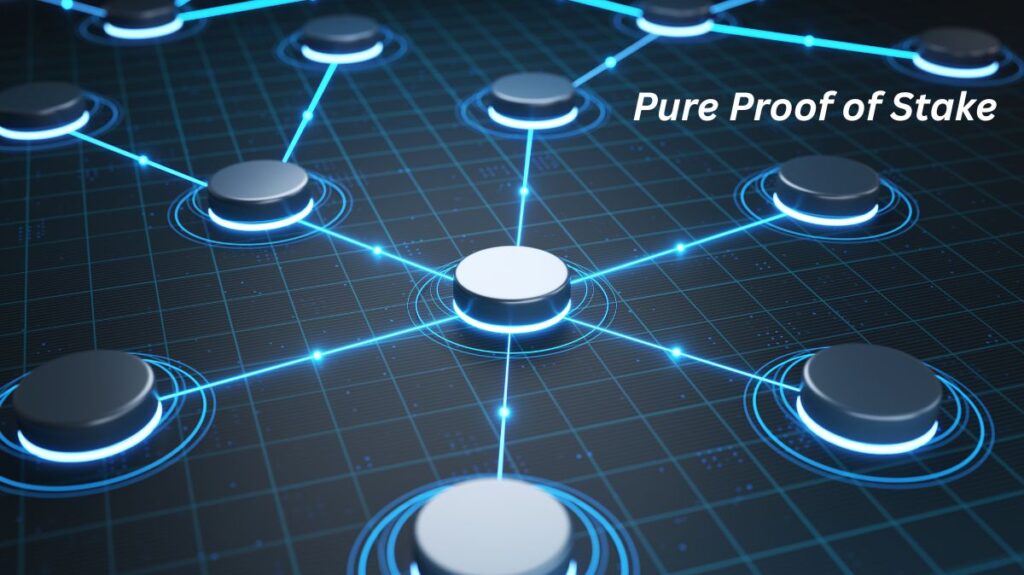What is pure proof of stake?

The amount of cryptocurrency that validators own and are prepared to “stake” (lock up) as collateral determines which validators are selected to produce new blocks under the Pure Proof of Stake (PPoS) consensus process in blockchain technology. It’s a variant of the conventional Proof of Stake (PoS) system and is renowned for using less energy than PoW.
Blockchain networks use the Pure Proof of Stake (PPoS) consensus mechanism to approve transactions and produce new blocks. It is the unique consensus technique of Algorand. A novel take on the classic Proof of Stake (PoS) process is PPoS.
Core Principle
- Users with a substantial ownership or interest in the specific coin are given the authority to validate block transactions in PPoS. Each user’s stake determines how much power they have on a new block.
- Users are chosen at random and in private by the system to vote on proposed blocks and create new ones. A user’s stake, or the quantity of coins they possess, determines how likely they are to be selected.
- In contrast to certain other PoS variants, PPoS allows validators to keep their tokens in their wallets while protecting the network, eliminating the need for them to lock them away in a different smart contract. This implies that consumers are always in charge of their Algo.
How it Works (Algorand’s Implementation)
- The PPoS consensus mechanism was invented by Algorand. Token ownership and cryptographic hashing work together to power the blockchain’s decision-making mechanisms.
- For every block, Algorand elects a new validator committee and a new block proposer, frequently in less than three seconds. From all accounts that have registered online to take part in consensus, the block proposer and committee members are chosen at random in a non-interactive, secret, probabilistic manner.
- Cryptographic sorting and Verifiable Random Functions (VRF) are used to accomplish this random selection. By computing the VRF using a safe and impenetrable network-wide randomisation seed, users can independently ascertain whether they have been selected.
- In order to prevent malevolent users from influencing the randomisation seed, those who wish to take part in consensus must register their “participating status” 320 blocks beforehand. Adversaries are unable to determine which user to attack until their task is finished due to the non-interactive nature of membership selection.
- Users and nodes are the two participant kinds on the Algorand platform. Block Producers (BPs) are special nodes that carry out all of the tasks of a regular node and sign blocks to ensure they are authentic. The Binary Byzantine Agreement (BBA), a multi-round Byzantine agreement protocol, is used to elect a leader for each block cycle, which is chosen by randomly chosen BPs at the beginning of block generation.
Key Features and Benefits
Decentralization
PPoS seeks to disperse power more widely and lower the risk of centralization by permitting any user with a stake to be chosen at random. Algorand enables a genuinely decentralized network with no specific nodes or responsibilities to its uniform token distribution.
Security
By making it harder for malevolent actors to forecast who will validate blocks, the random selection process improves security. Algorand’s asymptotic security against Byzantine adversaries can be demonstrated. As long as honest participants hold a supermajority of the stake (more than 2/3) the network can withstand malevolent actors and prevent forks and double-spending. Algorand’s “speak-once” architecture prevents DDoS attacks by making nodes hard to target.
Efficiency & Scalability
PPoS utilises less energy than PoW due to simpler computations. Thus, energy costs and usage drop significantly. Less processing means faster block processing, so the network can handle more transactions without losing security or speed. A key component of cryptographic sorting, the VRF computation is scalable and lightweight regardless of the number of Algo invested.
Also Read About Blockchain Truffle: Smart Contract Development Framework
Immediate Finality
With a block delay of less than three seconds and a large transaction rate (about 10,000 per second), Algorand is able to achieve immediate finality for blocks, which translates to instant confirmation time. There are no rollbacks and very small transaction fees because transactions are finalised as soon as they are in a block.
Accessibility
People who might not have the funds for conventional mining can participate to PPoS. A computer, an internet connection, and some cash are all that are required. Algorand makes it simpler for users to contribute to network security by having low minimum staking requirements, such as only requiring one ALGO token.
Sustainability
By minimising wasting energy on forks or block reorganisations, PPoS minimises energy usage without sacrificing sustainability. Since 2021, Algorand has maintained carbon neutrality.
User Experience
Users can stake on Algorand without any lockup periods or cutting risk (a technique that penalises malicious conduct), and they can get payouts in real time.
Distinction from other Proof of Stake models
In contrast to delegated Proof of Stake (DPoS) and bonded Proof of Stake (BPoS), the stake in Algorand’s PPoS is neither delegated nor locked. A key distinction that protects delegated validators against DDoS assaults.
Algorand’s PPoS, which prioritises decentralization, sustainability, and efficiency to construct a powerful and scalable network, is a blockchain invention.
